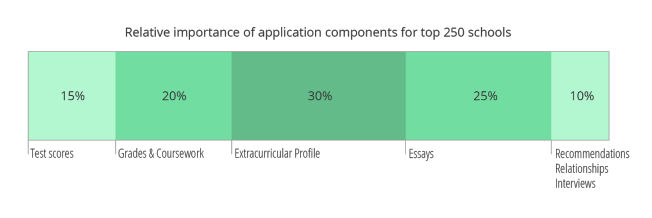6 Myths About High School Extracurriculars
Extracurricular activities can be anything students have accomplished outside of the normal high school classroom. This sounds simple enough, but over time, certain myths about extracurriculars have been spread, making it confusing to decide which activities to pursue. We at CollegeVine want students and parents to be as informed as possible, so we’ll be debunking the most common myths about high school extracurriculars. In fact, the opposite is true. Of all the components of your college application, admissions counselors at the top 250 schools in the US tend to weigh your extracurricular profile more heavily than your test scores, grades and coursework, essays, and other components. Your extracurricular involvement matters so much because it gives admissions counselors key insight into your personality and interests. Most students are required to take similar courses in high school, and test scores only provide an indication of academic aptitude. Extracurriculars, however, are unique to each individual. These activities tell admissions counselors what kinds of communities and activities you are drawn to. They also indicate what skills you’ve developed outside of the classroom, and what you could contribute to their campus community. Remember that college isn’t only about academic success—schools want to build successful people, and extracurriculars show your potential. Admissions committees are made up of people, and every person has their own biases. Thus, many students and parents assume that the evaluation of your extracurricular involvement will heavily depend on who is evaluating your application. For example, being president of the Debate Team may seem more impressive to certain admissions committees than others. This notion can make it difficult and even discouraging for students trying to pick which extracurriculars to get involved in. Thankfully, this isn’t necessarily true. College admissions committees try to exclude their own personal biases as much as possible from the selection process, and many have standardized ways of evaluating a student’s extracurricular profile. Rather than thinking about extracurricular evaluation as a subjective process, it might be more helpful to think of it as a ranking process. We at CollegeVine divide a student’s extracurriculars into four tiers. Tier 1 extracurriculars are the most exceptional, and Tier 4 are the most common. Let’s dive into each tier individually. We’ll start with the Tier 4 activities. These are the extracurriculars in which you simply participated. You didn’t hold a leadership position, and you didn’t make an individual lasting contribution. Examples of Tier 4 activities include playing in the school orchestra, volunteering at an animal shelter, or joining Spanish Club. You should absolutely include these in your college application as a way to showcase your interests to an admissions committee, but they won’t likely help you stand out amongst other applicants. Tier 3 activities are a bit more impressive than Tier 4 activities because they involve more work and dedication. Consider your Tier 3 extracurriculars those in which you held some of honor or leadership positions. These include placing at a Debate Tournament, being the Treasurer or Secretary of your school club, or even being a varsity athlete. These are noteworthy accomplishments to be sure; however, there are many students across the US who also share similar accomplishments. Tier 2 activities are where most applicants start to stand out. These are the impressive extracurricular accomplishments, like being class president or making the all-state orchestra. These activities show great dedication and leadership. Most students peak at this level of extracurricular accomplishment. Having two or three Tier 2 activities on your college applications is sure to impress an admissions committee. Finally, there are Tier 1 Activities. These are truly extraordinary accomplishments that are rare to see in college applicants. These are the types of activities that very few students can accomplish, like winning the national Mock Trial competition, gaining admission to a prestigious summer program, or winning a national art award. If you can get a Tier 1 activity on your resume, you will definitely gain the attention of admissions committees. With this ranking system, you can get a better idea of how your extracurricular involvement will compare to other applicants. Students often think that they need tons of different activities to impress admissions committees. However, this actually isn’t the best approach. When a student is too involved, they often only have surface-level participation in each of their activities. So, when it comes time to talk about their extracurriculars on their college applications, they have no really noteworthy accomplishments to speak of. It’s true that the most competitive applicants will have 8-10 activities on their Common App, but keep in mind that these activities aren’t necessarily happening at the same time (like seasonal sports or clubs). These competitive applicants also center their activities on a few themes, like leadership, science, and sustainability. For example, a weak extracurricular profile would be a student who participated in 15 clubs, but didn’t hold any leadership positions, and didn’t figure out their true passions. A strong profile would be a student with 8 activities, with 4 centered on environmental science, and 4 on leadership and politics. They might have been class president, and may also have fundraised $10,000 for an environmental non-profit. Many students and parents think that you need community service on college applications. While colleges like to see students give back to the community, remember that volunteering is a Tier 4 activity. Anyone can do it, so it’s not that impressive, even if you rack up hundreds of hours. Of course, we don’t mean to discourage you from volunteering—you absolutely should get involved in the community! Just don’t assume that spending every weekend at the animal shelter will boost your application, and don’t pursue community service only to “look good.” Think about your passions and how you can use them to give back, and that will make for a meaningful volunteer experience that will solidify your application theme. For example, a student passionate about music could gather their friends and start a nonprofit that gives free music lessons to underserved kids. Or, a student passionate about menstrual equity could start a pad, tampon, and menstrual cup drive for the homeless. Music and sports are some of the most common high school extracurriculars, and many believe that they’re impressive to colleges. The problem is that they both take a significant amount of time and commitment, often with little payoff. Most musical and athletic involvements are only Tier 3 or 4 activities, but students spend countless hours on group practice, performances/games, lessons, and individual training. If you don’t love your music or sports involvements, you should consider using your time more efficiently, by pursuing extracurriculars in which it’s easier to achieve a higher tier. For example, you might train for a half marathon instead of running on the track team (or do both, as you’ll already have the training base). Or, you might start that aforementioned music nonprofit instead of playing in the school orchestra. If you love music and sports, you can certainly continue them, especially if you’re already high-achieving (like being an all-state musician or athlete). This advice is mainly for students who don’t truly love what they’re doing. Colleges use your extracurricular involvement as an indicator of who you are and where your interests lie, so they’re not looking for a specific set of activities. A college will be equally impressed if you were the president of the gaming club as if you were the president of Key Club. So when you’re choosing your extracurriculars, don’t fall for the myth that you have to join certain clubs in order to get into a good college. Focus instead on being a part of things that you have a passion for, and let your extracurricular achievements shine through in your college application. Now that you won’t be falling for any common misconceptions about high school extracurriculars, you’re free to build an extracurricular profile that sets you up for college admissions success. How competitive is your profile in terms of gaining you admission to the school of your choice? That’s a difficult question to answer, but we at CollegeVine make it easier with our free chancing engine. Based on your academic and extracurricular profile, we’ll let you know how you stack up against other applicants, and we’ll also give you expert tips on how to improve your profile. Sign up for your free CollegeVine account today!1. Extracurriculars aren’t important in college admissions.

2. Extracurricular impressiveness is totally subjective.
3. You need to have a ton of extracurriculars.

4. Volunteering is essential.
5. Music and sports are strong extracurriculars.
6. You need a certain type of extracurricular for top schools.


